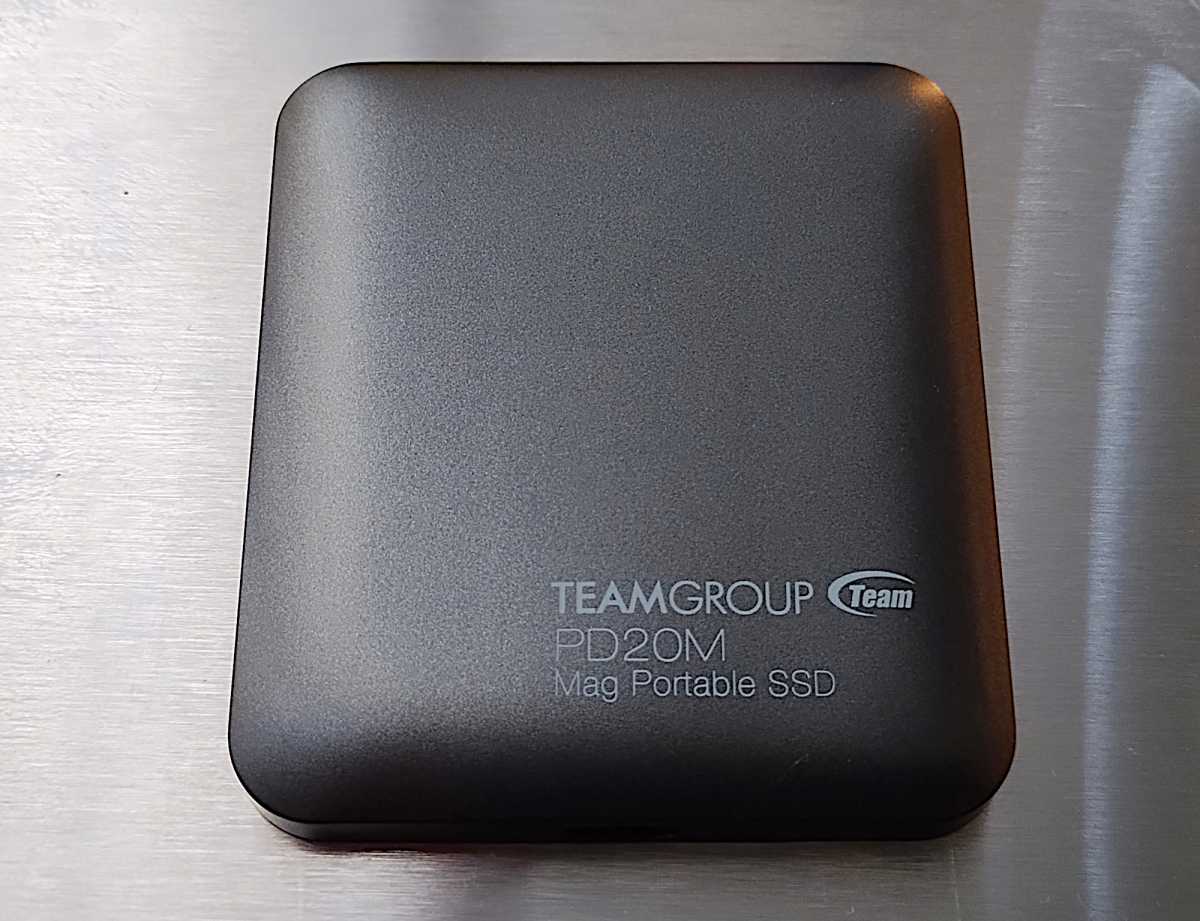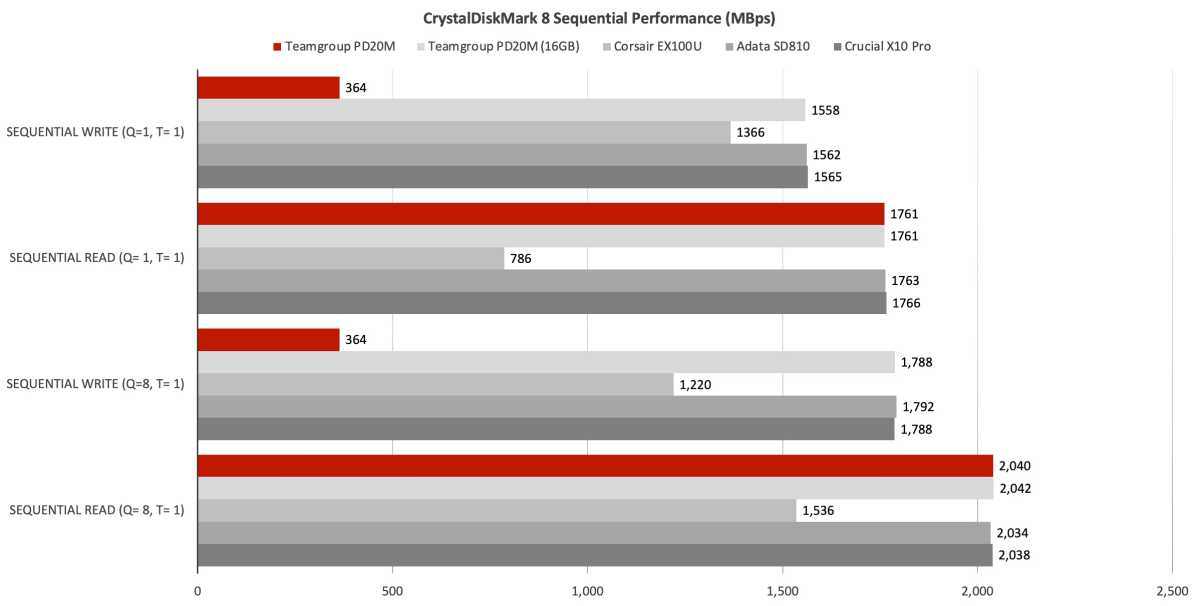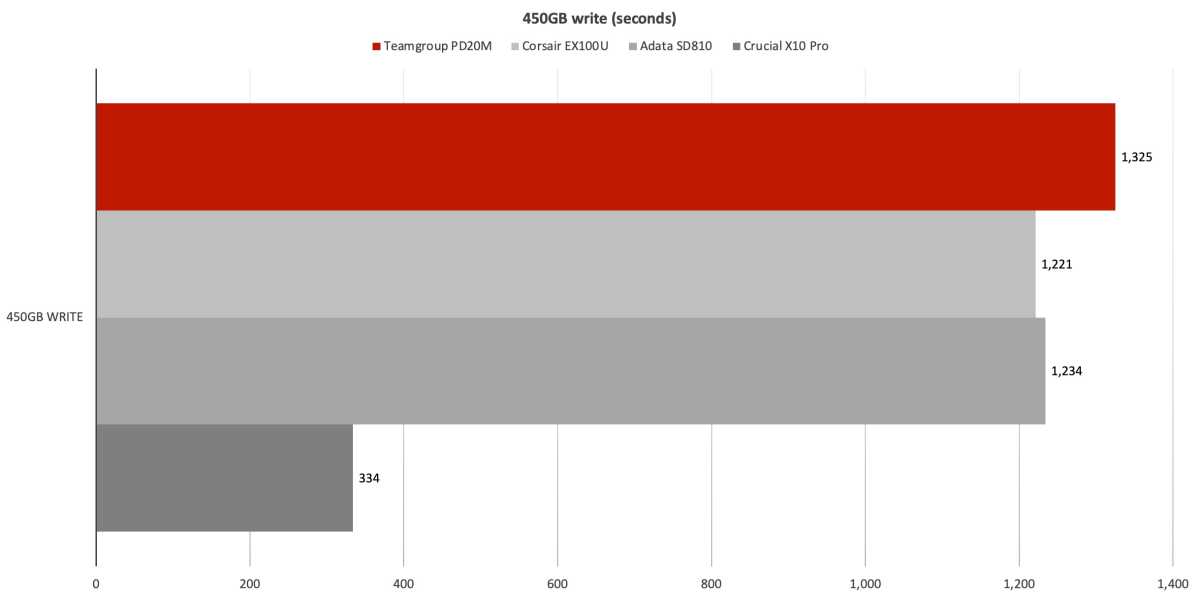Expert's Rating
Pros
- Great 20Gbps read performance
- Handy form factor with travel case
- Weighs only slightly over an ounce
Cons
- Slows drastically when writing over 20GB of data
Our Verdict
For light duty, the 20Gbps Teamgroup PD20M SSD will get the job done. But slow write performance with larger data sets means pros should look elsewhere.
Best Prices Today: Teamgroup PD20M
While being a decent 20Gbps USB SSD with light workloads, the Teamgroup PD20M is not the drive for writing large data sets on a continual basis. The parsimonious 20GB of cache on our 1TB test unit had it dead last overall in our performance ratings.
That’s a shame, because it’s also one of the lightest and most attractive SSDs we’ve tested — i.e., it travels well, especially with the handy carrying case that Teamgroup bundles.
Further reading: See our roundup of the best external drives to learn about competing products.
What are the Teamgroup PD20M’s features?
The PD20M is a 20Gbps USB 3.2×2 external SSD sporting a thin, but squarish profile measuring 2.45-inches wide, by 2.75-inches long, by a mere 0.32-inches thick. The top is rounded, while the bottom is perfectly flat.
Unusually, there’s no anti-skid material on the bottom of the unit, but it makes perfect sense: The PD20M weighs a mere 1.1 ounces on its own, and only 1.3 ounces with the Type-C cable that plugs into one edge. With so little heft for gravity to effect, you’d have to use semi-adhesive tape to secure this featherweight puppy in place.
The PD20M is the lightest SSD we’ve ever tested.

The large upside is that if you’re looking for an SSD you can dangle off of a port without damaging it, this is it. Performance concerns aside, that is. Just be careful that you don’t forget it’s in your pocket and put it through the wash!
Teamgroup warranties the PD20M for three years, but no mention is made of the warranty’s TBW (terabytes that may be written) rating. Given the drives slow write rate when cache runs out, which was rather early on the 1TB version we tested, you should never have to worry about writing so much data that the company considers it unfair usage.
How much does the Teamgroup PD20M cost?
The PD20M is available in 1TB and 2TB capacities, which retail for $110, and $165, respectively. Given the performance, that’s a tad pricey. Indeed, when we checked Amazon, the mighty 1TB Crucial X10 Pro, a far superior SSD, was available for $100. Hopefully, the PD20M will drop in price significantly in short order.
How fast is the Teamgroup PD20M?
In our initial testing, the Teamgroup PD20M turned in a far lower (364MBps) CrystalDiskMark 8 sequential write number than the 2GBps claimed on the box. It finally wrote at 1.8GBps, but only after I reduced the size of the 64GB data set I normally use four-fold to 16GB.
Ie’ve included both the 64GB and 16GB results to illustrate exactly how important cache, and the lack thereof can be.

Note again, that the PD20M we tested was a 1TB drive. The Corsair EX100U on the charts, which experienced similar slowdowns at one point or another, was a 2TB drive. If Teamgroup has sent us the 2TB version, it likely would’ve outpaced the Corsair.

The Crucial X10 Pro is a much faster drive, and given that it’s currently $10 less for 1TB, and only $10 more than the PD20M for 2TB, there’s little reason to opt for latter other than weight.
The parsimonious caching again showed up in our real-world transfers. While the PD20M was not the slowest external SSD we’ve tested (there are four or five slower 10Gbps units), it was easily the slowest 20Gbps SSD we’ve seen.

Below you can see where the PD20M ran out of cache — at around the 20GB mark.

The story was no better in the 450GB write, which basically proceeded at 364MBps from the relative get go. Slow.

In truth, few users write even 48GB at a time, so like the Corsair EX100U, the RD20M will do the job the majority of the time when writing — and all of the time when reading.
Should you buy the Teamgroup PD20M?
The PD20M is fine for light duties, but the write slowdowns occur far to early, at least on the 1TB model, for me to recommend it for anything other than a light-duty drive. Also, compare prices. At least at the moment, there are numerous 20Gbps SSDs, some of them far more consistent performers, for less.
How we test
Drive tests currently utilize Windows 11 (22H2) 64-bit running on an X790 (PCIe 5.0) motherboard/i5-12400 CPU combo with two Kingston Fury 32GB DDR5 modules (64GB of memory total). Intel integrated graphics are used. The 48GB transfer tests utilize an ImDisk RAM disk taking up 58GB of the 64GB total memory. The 450GB file is transferred from a Samsung 990 Pro 2TB, which also contains the operating system. For external drives, the motherboard’s dedicated Thunderbolt 4 and 20Gbps USB ports on the rear panel are used.
Each test is performed on a newly NTSF-formatted and TRIM’d drive so the results are optimal. Note that as any drive fills up, performance will decrease due to less NAND for secondary caching, and other factors.
The performance numbers shown apply only to the drive we were shipped as well as the capacity tested. SSD performance can vary by capacity due to more or fewer chips to read/write across and the amount of NAND available for secondary caching (writing TLC/QLC as SLC). Vendors also occasionally swap components.
If you ever notice a large discrepancy between the performance you experience and that which we report (systems being roughly equal), by all means—let us know.





